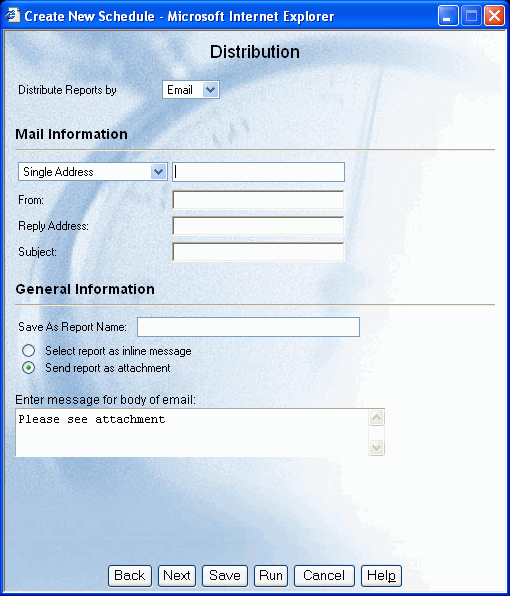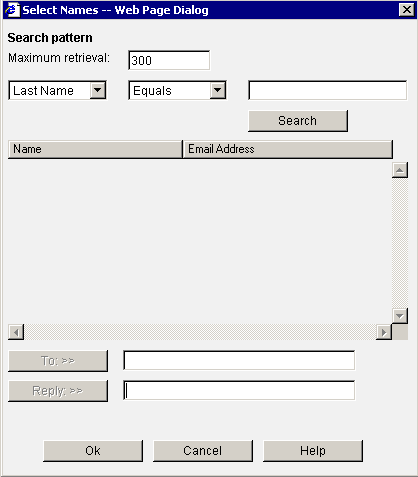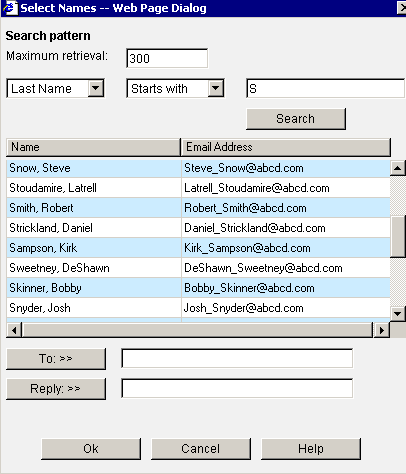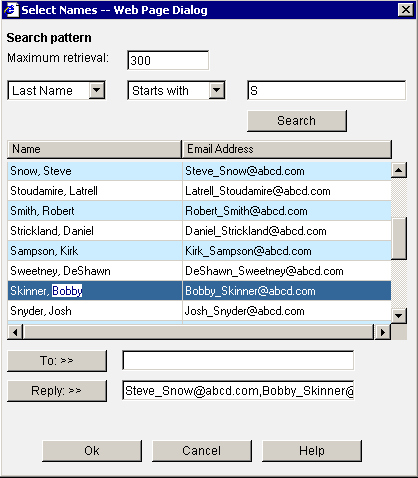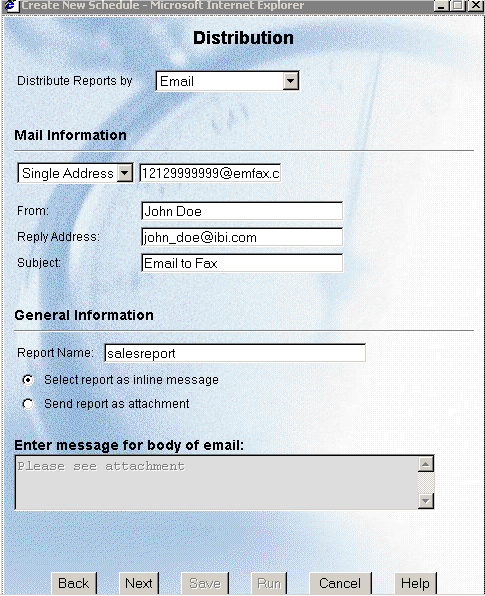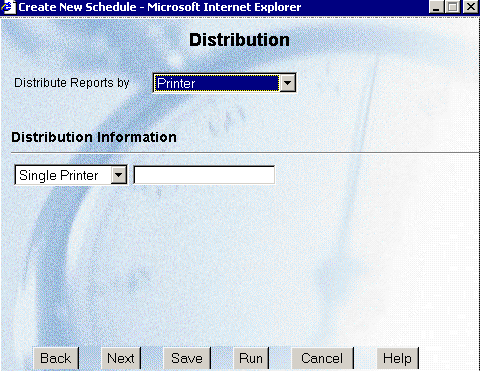You can distribute a report as an e-mail attachment or within the body of an e-mail message (inline). Distributing a report as an inline e-mail message is particularly useful when the report is distributed to mobile devices, fax machines, or through e-mail systems that do not support attachments. For more information about distributing a report to a fax machine, see Distributing a Report to a Fax Machine Using E-mail.
Note: The availability of the inline message option when you create a schedule depends on the Inline Report Distribution setting in the ReportCaster Server Configuration tool. See the ReportCaster Administrator to enable this option.
To distribute a report using e-mail:
-
In the
Distribution window, select Email from the
Distribute Reports by drop-down list.
The following image shows the Distribute Reports by Email window, which contains options to specify the e‑mail destination of the report, the reply address, and whether the report will be distributed as an e-mail attachment or within the body of an e-mail message (inline).
-
From
the Mail Information drop-down list, select Single Address, Distribution
File, or Distribution List.
Note: If the Email Delivery, Restrict Email Domains option is set to yes in the ReportCaster Server Configuration tool, then only those e-mail domains (the portion of the e-mail address following the at symbol) listed in Allowed Email Domains (also in the Server Configuration tool) are valid e-mail recipients.
-
Single Address. In
the accompanying text box, type the e-mail address of the single
recipient. ReportCaster cannot validate the e-mail address. An incorrect
or unresolved address may not be noted in the log file. This is dependent
upon the ability of the SMTP mail server to validate the e-mail
address. The SMTP mail server returns undeliverable e-mail messages
to the reply address you specify for the schedule.
Tip:
- You can specify multiple e-mail addresses within the Single Address option. Separate each e-mail address with a comma or a semicolon. The e-mail addresses will appear in the To line of a single e-mail when the scheduled output is distributed. Each individual e-mail address can be a maximum of 130 characters as per SMTP specification. The total maximum length of this field is 800 characters.
- Additionally, you can use group mail lists (defined on your mail server) with the Single Address option. Group mail lists enable you to distribute a report or notification to multiple recipients without having to maintain multiple e-mail addresses in the ReportCaster Repository. The format of the group mail list is dependent upon the mail server being used. For example, if you are using a Microsoft Exchange Server and your group mail list is defined as #group1, you would enter group1@listdomain in the Single Address field. If the group mail list contains a space within its name, it must be enclosed within quotation marks. For more information, see your mail server administrator.
- You can retrieve e-mail addresses defined in an LDAP data source. For more information, see How to Retrieve E-mail Addresses for a Schedule Using Address Search.
-
Distribution File. In
the accompanying text box, type the full path and file name of an
external distribution file. The path and file must be accessible
to the ReportCaster Distribution Server.
The external distribution contains comma-delimited records that specify e-mail addresses, burst values, and encryption information. Distribution Files can also be automatically deleted after a schedule runs. For information on Distribution Files, contact your ReportCaster Administrator or see the ReportCaster Development and Administration manual.
Tip: You can specify multiple e-mail addresses within a single record of an external distribution file. For more information, see Specifying Multiple E-mail Addresses.
-
Distribution List. The following
image shows the Select Address drop-down list.
From the Select Address drop-down list, select a Distribution List. Note that this drop-down list displays all e-mail Distribution Lists that you are the owner of, and all public e-mail Distribution Lists. For more information about creating a Distribution List, see Creating and Maintaining a Distribution List.
-
Single Address. In
the accompanying text box, type the e-mail address of the single
recipient. ReportCaster cannot validate the e-mail address. An incorrect
or unresolved address may not be noted in the log file. This is dependent
upon the ability of the SMTP mail server to validate the e-mail
address. The SMTP mail server returns undeliverable e-mail messages
to the reply address you specify for the schedule.
- In the From field, type any value (for example, the name of the person creating the schedule). This field is not required by ReportCaster, but may be required by your e-mail system.
-
In the
Reply Address field, type a valid e-mail address. If recipients
reply to the e-mail, their messages are sent to this address. If
your e-mail system is unable to deliver the content, the undeliverable
output message is also returned to this address. This field is required
by ReportCaster.
Tip: You can retrieve e-mail addresses defined in an LDAP data source. For more details, see How to Retrieve E-mail Addresses for a Schedule Using Address Search.
-
In the
Subject field, type the text you want to appear in the e‑mail subject
line. This information is not required by ReportCaster, but may
be needed by your e-mail system. If you do not type an entry in
this field, the text that was entered in the schedule Description
field will appear in the subject line of the e‑mail.
When creating a schedule, you can place multiple parameters and burst values from the scheduled procedure in an e-mail subject line. This allows the subject to be dynamically created in order to personalize e-mails to recipients. Parameters referenced in the subject line must be stored with the schedule information in the ReportCaster tables.
Parameters must be specified in the format '&parmname' (where parmname is the name of the parameter). Burst values must be specified using the syntax '%BURST'.
Note:
- The parameter name cannot also be the name of an existing WebFOCUS procedure. You can specify an unlimited number of parameters.
- If you have multiple burst values in a Distribution List, only the first value sent to the ReportCaster Distribution Server is included in the subject.
For an example of specifying parameters and burst values in an e-mail subject line, see Specifying Parameters and Burst Values in an E-mail Subject Line.
-
In the
Save As Report Name field, type a name for the report to be distributed.
By default, this value is populated as descname.ext, where descname is the descriptive name of the Managed Reporting procedure, and ext is the extension for the format you selected, for example, Regional Sales.htm. If the report is burst, it is distributed as Regional Sales_burstvalue.htm. If you decide to change the default value, and you specify an extension, be sure to specify the extension of the format you selected. If you do not specify an extension, ReportCaster automatically uses the extension of the format you selected. If you are distributing the report to the Report Library, the category name under which the report is stored is the domain name.
-
Specify
whether you want to distribute the report as an e-mail attachment
or within the body of the e-mail message (inline). (The availability
of the inline option depends on your ReportCaster configuration.)
- If you want
to distribute the report within the body of an e-mail message, select
the Select report as inline message option.
When distributing to PDA or Blackberry, check the capabilities of the device. If the device does not support attachments, use the inline option. The WP format is recommended.
- If you want to distribute the report as an e-mail attachment, select the Send report as attachment option. If you want to send an optional message within the body of your e-mail, type the message in the Enter message for body of email text box. The message can contain a maximum of 256 characters.
- If you want
to distribute the report within the body of an e-mail message, select
the Select report as inline message option.
- To continue to the Settings window, click Next. For more information, see Priority, Notification, and Zip File Options.
Note: For information on the e-mail distribution method, see Considerations When Distributing a Report Using E-mail.
The following image shows a schedule that specifies burst values and multiple parameters in the e-mail subject line.
This schedule will produce an e-mail similar to that shown in the following image.
The Address Search options only appear if your ReportCaster Administrator has set the Email LDAP Enabled parameter to YES in the ReportCaster Server Configuration tool. If the Address Search options do not appear, contact your ReportCaster Administrator.
To retrieve e-mail addresses for a schedule using Address Search:
-
While creating or editing a schedule,
click the Address Search icon that appears
next to any e-mail address field.
The following image shows action buttons, input fields, and drop-down lists in the Address Search pane.
-
In the
Search Pattern fields, type the search string. You can search using
the following combinations:
- Last Name [Equals | Starts with | Ends with | Contains]
- First Name [Equals | Starts with | Ends with | Contains]
- Email [Equals | Starts with | Ends with | Contains]
For example, if you type S after the Last Name Starts with field, as shown in the following image, ReportCaster retrieves all last names that start with the letter S.
Note: By default, ReportCaster retrieves a maximum of 300 e-mail addresses. You can change this default value for the duration of your session. However, if you log out and log back in, the Address Search window displays the default value of 300. ReportCaster allows the retrieval of a maximum of 500 e-mail addresses. If you suspect your search will return more than 500 records, you should refine your search criteria.
-
Click Search.
ReportCaster retrieves the specified names from the LDAP data source.
The following image shows retrieved search data under the Name and Email Address column headings in the Address Search pane.
-
Select
an e-mail address you want to use in your schedule, and then click
the field (for example, Reply) for which you want to insert the
e-mail address. Repeat this process if you want to select multiple
e-mail addresses.
Note:
- Alternatively, double-click an e-mail address to automatically insert it into the field for which you clicked the Address Search icon.
- If the Email Delivery, Restrict Email Domains option is set to yes in the ReportCaster Server Configuration tool, then only those e-mail domains (the portion of the e-mail address following the at symbol) listed in Allowed Email Domains (also in the Server Configuration tool) are valid e-mail recipients.
The following image shows a highlighted data selection under the Name and Email Address column headings in the Address Search pane.
-
Click OK to
insert the e-mail address(es) into your schedule.
The following image shows that the e-mail addresses have been added to the Reply Address field.
By default, ReportCaster separates multiple e-mail addresses with a comma. The e-mail addresses appear in the To line of a single e-mail when the scheduled output is distributed.
Note: Repeat these steps if you want to change your search criteria or insert additional e‑mail addresses into your schedule. If you insert additional e-mail addresses while the original e-mail addresses are selected, the new e-mail addresses replace the old ones. If your cursor is positioned after the original e-mail addresses, the new e-mail addresses are appended to the old ones, separated by a comma. However, be aware that the maximum number of characters is 800 when inserting addresses.
To distribute an inline e-mail message to a fax machine, you must register your e-mail address with a third-party e-mail distribution provider. The features offered by providers, (such as supported area codes and file formats), in addition to requirements on the structure of e-mail parameter values, may vary. It is important that you select a provider whose features are compatible with ReportCaster.
The following example shows how to distribute a report directly to a fax machine. The e-mail address, john_doe@ibi.com, was registered with the e-mail distribution provider called emfax.com. During the processing of the request, ReportCaster generates the scheduled report output and then distributes it using the e-mail address of emfax.com. The reply address specified in ReportCaster is the registered e-mail address that is validated by emfax.com. If the e-mail address is valid, emfax.com distributes the report to the fax number 12129999999. The validation of the registered e-mail address is performed by emfax.com, not by ReportCaster.
Note: The syntax used in this illustration is specific to this example. The required syntax for your provider may be different.
- On the Distribution
window, select Email from the Distribute
Reports by drop-down list.
The following image shows the Distribute Reports by Email window, which contains fields, drop-down lists, and option buttons that enable you to specify the destination(s) for the scheduled report, an e-mail address to which report recipients can reply, the name of the report to be distributed, and whether you want to distribute the report as an e-mail attachment or inline within the body of an e-mail message.
- From the Mail
Information drop-down list, select Single Address.
In the accompanying text box, type the e-mail address to be used by the e-mail provider according to their requirements. In this example, it is phone-number@emfax.com or 12129999999@emfax.com (where emfax.com is the name of your e-mail provider).
Note: You can also select a Distribution List or a Distribution File. However, be sure to use the syntax required by your provider.
- In the From field, type any value (for example, the name of the person creating the schedule). This field is not required by ReportCaster, but may be required by your e-mail system or by the e-mail provider.
- In the Reply Address field, type your registered e-mail address. If your e-mail system is unable to deliver the content, the undeliverable output message is returned to this address. This field is required by ReportCaster.
- In the Subject field, type the text you want to appear in the e‑mail subject line. This information is not required by ReportCaster, but may be needed by your e-mail system or e-mail provider.
- In the Report Name field, type the name of the report to be distributed.
- Select the Select
report as inline message option button.
Note: You cannot distribute an e-mail attachment to a fax machine.
- To continue to the Settings window, click Next at the bottom of the Distribution window. For more information, see Priority, Notification, and Zip File Options.
If the Email Delivery, Restrict Email Domains option is set to yes in the ReportCaster Server Configuration tool, then only those e-mail domains (the section of the e-mail address following the at (@) sign) listed in Allowed Email Domains (also in the Server Configuration tool) are valid e-mail recipients. The Distribution Server will not deliver output to an e-mail address whose domain is not on this list. Instead, the schedule will fail and an error message will be written to the ReportCaster log.
ReportCaster transfers e-mail asynchronously to your e-mail system. The delivery time depends upon your e-mail system.
Exchange Mail Server Considerations:
- If you do not
see a From value that is specified in the schedule information for
the e-mail you receive in the e-mail client inbox, then this is
due to their mail server configuration. For more information on
how to control this setting for a Microsoft Exchange Server, see
the following URLs:
- http://support.microsoft.com/default.aspx?scid=kb;en-us;288635
- http://support.microsoft.com/kb/174755/EN-US/
- http://support.microsoft.com/default.aspx?scid=kb;en-us;242301
Alternatively, you can contact Microsoft customer support for assistance. If you are using a mail server other than a Microsoft Exchange Server, refer to that vendor's documentation or contact their customer support for assistance.
- When distributing a report to an Exchange Server, attachment names have a .txt extension added to WP and DOC format output. This occurs because WP and DOC formats are not mapped to a standard MIME type. The Exchange Server interprets WP and DOC output as a text/plain MIME type and adds the .txt extension to the end of the file name. For example, hold.wp.txt or hold.doc.txt.
- Exchange Server individual recipient names (person@company.com) and Exchange Server-defined distribution lists (list@company.com) can be specified in ReportCaster Distribution Lists. However, Exchange Server user-defined distribution lists cannot be referenced in a ReportCaster Distribution List. They are defined internally on the user's machine. The ReportCaster Distribution List is parsed by the Exchange Server and not the user's mail client. Since a ReportCaster Distribution List is parsed by the Exchange Server, when an external server submits an Exchange Server distribution list, it must contain the proper prefix and the proper domain (which is prefaced by an at (@) sign). Consult your Exchange Server Administrator for these values.
CC:Mail Considerations:
When you distribute ReportCaster generated e-mail attachments greater than 20K in size to users of cc:Mail, cc:Mail renames the attachment textitm.txt, ignoring the file name and extension supplied by the user. This change affects DOC, HTML, and WP formats on UNIX and Windows platforms. However, despite the naming convention issue, the attachments contain the correct output and can be viewed if the attachment is saved to disk with the correct extension.
